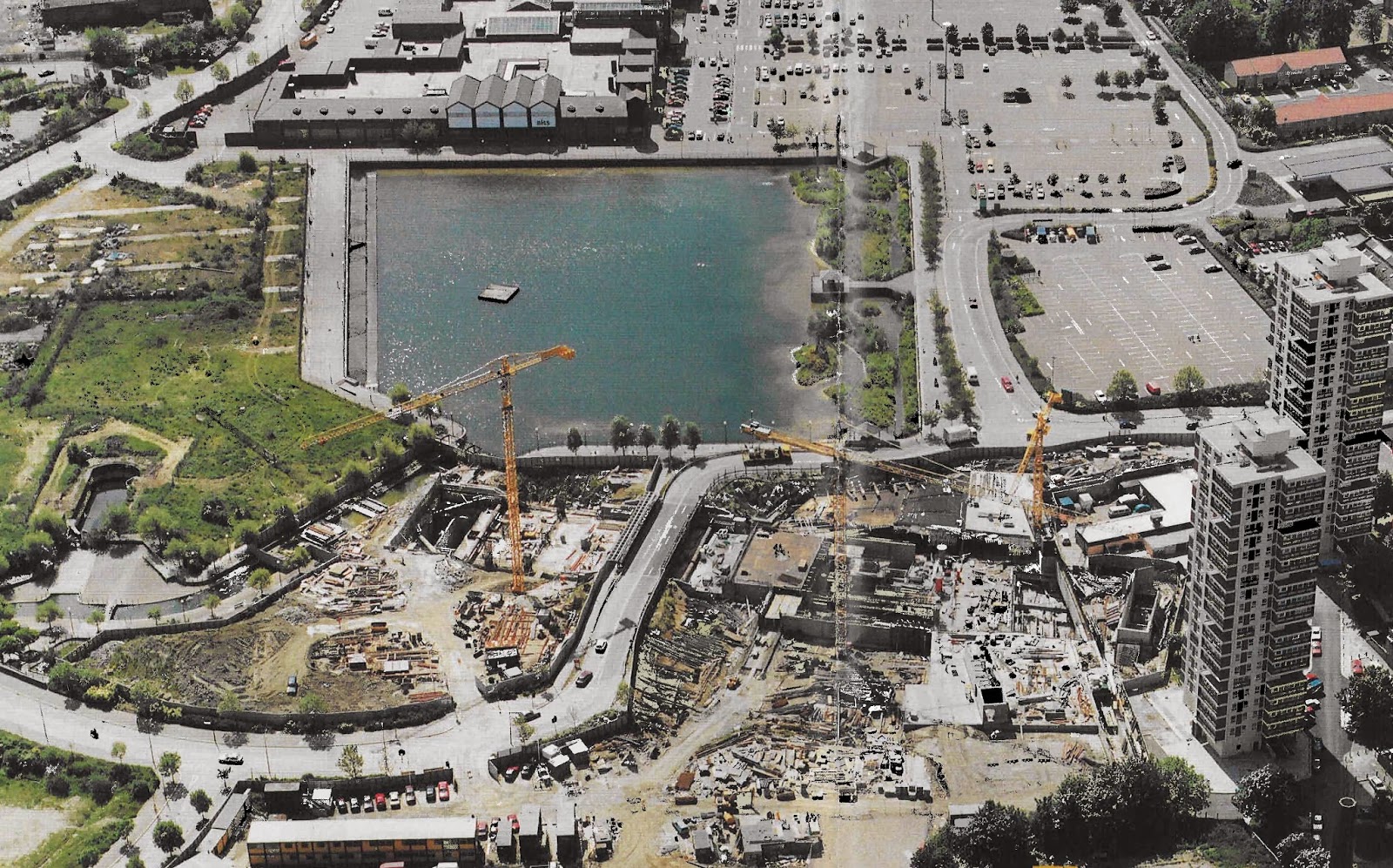 |
| Canada Dock under construction 1875-6 |
Canada Dock was established specifically to handle the larger iron vessels and their cargo. Engineer James Adair McConnochie, who had been appointed Resident Engineer to the Surrey Commercial Dock Company in 1865, was chief engineer on the project. McConnochie was a successful engineer who worked in a number of British docks and was also responsible for attractive dockside architecture like the Surrey Docks Office opposite Canada Water tube station. The dock was established on the last segment of land at the base of the peninsula, and was right up against both existing buildings along Lower Road and the immovable presence of the East London Railway. McConnochie's main challenge was to resolve problems caused by the close proximity of the East London Railway, which was semi-subterranean and could have been under threat from both subsidence and leakage from the dock, had measures not been taken to prevent it. As a result, Canada Dock was equipped with vast concrete walls. It also has a slightly curved shape, which reflects that its upper part had to be built along the line of the railway.
Canada Dock replaced Albion Pond and most of Canada Pond, but Quebec Pond and Centre Pond were retained to its east. Canada Dock was connected to Albion Dock, and from there it was linked into the rest of the network. The original cut from Albion Dock into Albion Pond was too small to be suitable for the new, larger ships that Canada Dock was built to handle, so this was closed at its southern end and converted into a small dry dock. A new entrance, wider and longer, was established to its west. Canada Dock was also connected to Canada Pond, which was in turn connected to Quebec Pond and from there to Centre Pond into Russia Dock and the Grand Surrey Canal.
Due to the new entrance (or "cut") between Canada Dock and the older part of the system, the old cut became redundant and was turned into a small dry dock for the repair and maintenance of barges and lighters. This was unearthed in 2016, during construction work at the sit. The dry dock has been named locally Albion Dry Dock and has been covered on a post of its own, here. The dry dock can be seen in the photograph at the very bottom of this page.
A contemporary account from 1878 was provided by Edward Walford (Rotherhithe. Old and New London; Volume 6, pages 134-142):
"The Commercial Docks have an entrance from the Thames, between Randall's Rents and Dog and-Duck Stairs, nearly opposite the King's Arms Stairs in the Isle of Dogs. They are the property of the Surrey Commercial Dock Company. A considerable extension of their area has been made within the last few years, with a view to meeting the increased requirements of the timber trade in the port of London, by the addition of a new dock which has been named the Canada Dock. It is 1,500 feet in length, 500 feet in width, and has a water area of sixteen acres and a half. It communicates with the Albion Dock by an entrance fifty feet in width, and the quay space around is upwards of twenty-one acres in extent."
Greenland Dock, which at that time was smaller than Canada Dock, had been the dominant of Rotherhithe's docks, but Canada Dock was much bigger and expanded the system's capacity for cargo handling and quickly began to equal Greenland Dock in importance for the Surrey Commercial Docks. It mainly handled grain and other food products imported from Canada.
 |
| Canada Dock in 1876 and 1914 |
If you compare the 1876 and 1914 maps, you can see how the ponds were re-arranged to enable the extension of Greenland Dock and its connection to Canada Dock. If you are using the Firefox browser you can right click and opt to open the image in a new tab, which will give you a much better view than left clicking the image. After its extension, Greenland Dock was connected to Canada Dock at the point where the current underpass to from Greenland Dock to Surrey Quays Shopping Centre passes under the road and red bascule bridge. Quebec Dock had to be truncated quite substantially to make room for the extension. This gave the most efficient linkage so far between the two systems that had formerly been separate and operated by competing companies.
Canada Water was closed when the Surrey Commercial Docks finally failed and were shut down for good in 1970. The Surrey Quays shopping centre car park
takes up much of the land that this occupied, with a small section of
the dock left behind to serve as a wildlife reserve. Amazingly, it was under threat from developers recently, but public reaction saved it from being destroyed.
 |
| Canada Water in 1996, the last patch that remains of Canada Dock, as it was during the construction of the Jubilee Line station, also called Canada Water. The Albion Dry Dock is shown at far left, centre. Photo from the London Docklands Past and Present site at (http://bit.ly/MQ4NRT) |
No comments:
Post a Comment